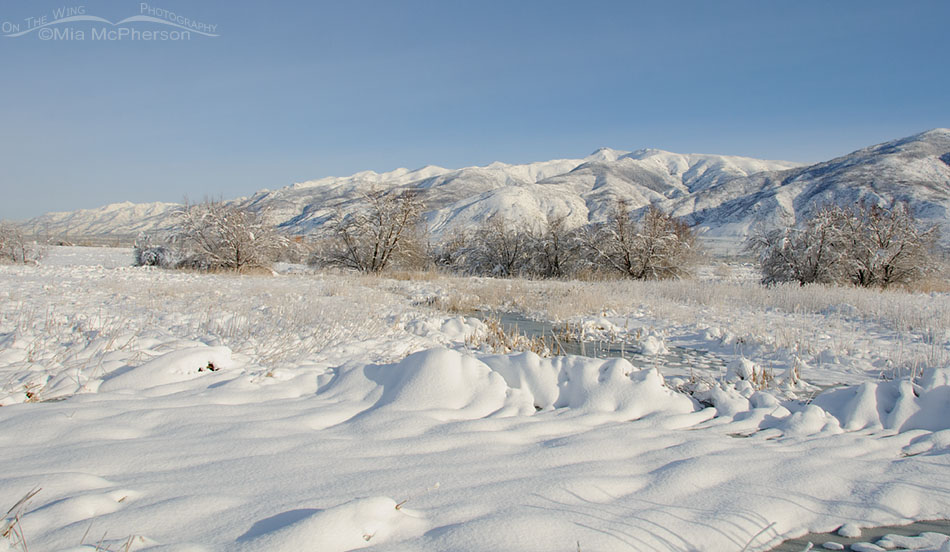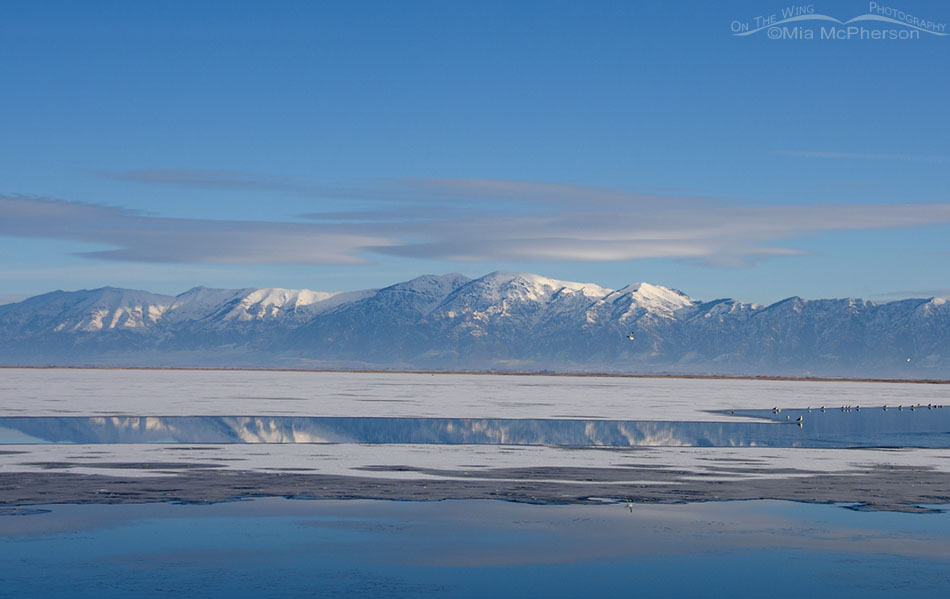 Farmington Bay WMA wetlands in winter 2015 – Nikon D300, f10, 1/800, ISO 320, Nikkor 18-200mm VR at 18mm, natural light
Farmington Bay WMA wetlands in winter 2015 – Nikon D300, f10, 1/800, ISO 320, Nikkor 18-200mm VR at 18mm, natural light
Yesterday temps tied the all-time hottest temperature ever recorded in Salt Lake City and broke the all-time June record when the thermometer hit 107°F. It felt even hotter than that because of our extreme drought conditions in the state.
Usually I don’t feel the need to look through my cooling winter landscape photos until mid July or early August to remind myself that the heat will pass when autumn and then winter arrive. According to the calendar that people have constructed it isn’t even summer here yet. We are still technically in the season we call spring.
If people are hot so are the birds and animals that live in our mountains, marshes, wetlands, plains, grasslands, sagebrush steppes, deserts and urban areas.
 Bear River MBR wetlands in winter 2020 – Nikon D810, f7.1, 1/3200, ISO 400, Nikkor 18-200mm VR at 52mm, natural light
Bear River MBR wetlands in winter 2020 – Nikon D810, f7.1, 1/3200, ISO 400, Nikkor 18-200mm VR at 52mm, natural light
Utah is hot. It is scorching. Our hottest temps are yet to come and there is no relief in sight for our drought.
I selected two photos to share today of the wetlands of Farmington Bay WMA and Bear River Migratory Bird Refuge in winter. Both photos show the Wasatch Mountain Range covered in snow. They do cool me down when I look at them but only temporarily because I know we are getting less snow in those mountains now than when I moved here in 2009. I also know that the reservoirs in those mountains that provide us with drinking water are currently at extremely low levels. Shockingly low.
For a moment I’m going to recall the cold, crisp air of winter, fresh snow and the beauty of Utah’s wetlands in the winter.
Mia
Click here to see more of my Utah landscape photos.


Very scary stuff. The 2015 vs 2020 snowfall comparison is startling. I hope this isn’t going to be our new normal; although a number climatologists are saying we should prepare for the worst. Thanks Mia.
I don’t know Utah but your fears mirror my own. My former home in beautiful Maple Ridge BC ( a community about 40K from the coast) hit a prolonged stretch of 40c this summer and Lytton BC more in the interior hit a terrifying 47.5 C. Were I still living in MR I doubt I would survive this heat and I worry for friends; the heat and accompanying drought also cause me considerable concern for the salmon, bears, eagles, herons, frogs and turtles. Since it is not even August yet I wonder if Lytton will soon become an uninhabitable dead zone? And from what climatologists tell us this will only get worse, all while we continue to burn coal and frack for gas. My only consolation is that I am old, that I now have a heat pump on the cooler east coast and have no children to worry about, even if I cannot stop worying about everyone else’s. Scary indeed.
I did not keep track of the actual temperature yesterday. When I went for my nightly bike ride at 7pm it did feel like the asphalt was belching heat back up at me. The magpies are taking turns sitting in my bird baths both yesterday and today. I might need to put another bath out.
I am so very sorry to read this and hope (fervently) that the heat and drought break. Soon.
How about planting some drought resistant shrubs and trees, add a birdbath or a ‘bubbler’ pond in the yard? Of course it can’t replace the climate, but it might be a good spot for wildlife to wait out the heat until cooler temperature again prevail.
I am so very sorry to hear about the drought and heat. Pity the wildlife.
Scary indeed. Because the likelihood is that it will only get worse. For the short term that means survival but long term my guess is that plants, animals and humans will have to abandon areas like this. And we have done this to ourselves, and to them. Sad, sad, sad. Wishing you fortitude in these trying times.
I saw on the news that you were having scorching temperatures. I fear this will become the normal. Poor you! We are having cool temps in Southern Ontario right now & feel so thankful.